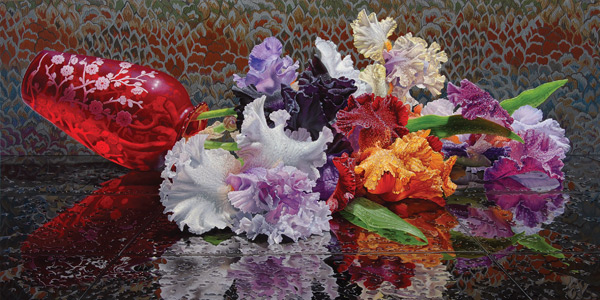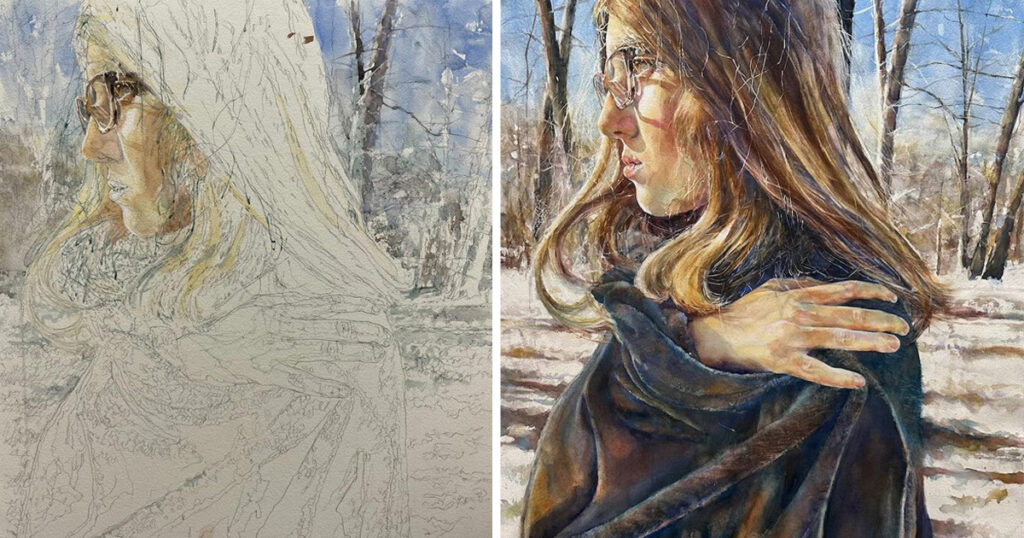Oil Painting Techniques | Paint Flowers With Eric Wert

Discover Eric Wert’s oil painting tips and learn how to paint flowers in still lifes full of dynamic detail and gorgeous lighting effects.
A recent exhibition of Eric Wert’s paintings drew two different reviews. “Sexy and sumptuous,” said one. “Melancholy,” said the other. Wert agrees. His paintings always contain luscious color, technical virtuosity and eagle-eye detail. The world he creates includes super-shiny glass vases on tables possibly strewn with water droplets, all set against gorgeous satin backdrops. On the other hand, the vases are often broken or overturned, and the flowers are head-down in the vases or tumbling out in disarray, sometimes with their petals scattered about, “suggestive of domestic disturbance, disaster or jilted love.” A Wert still life is the world gone awry, in a very beautiful way.

Although he has exhibited drawings, these days Wert works mostly in oil for its versatility and range of options from opacity to transparency. He embraces oil paint’s slow drying time because it allows him to delve into an extreme level of detail and to proceed slowly. But drawing still plays a big part in his painting process.
“I’m not prolific,” he says. In fact, he works on one painting at a time through a challenging 14-hour workday. He has learned to take several breaks each day and to include an hour of exercise as well. “I may not work fast, but I can be pretty focused when I get going. If I take a few days away from a complicated project, I ‘lose my place,’ and it can take a long time to build up steam again.” Most canvases take him two months to complete. —BJ Foreman
Oil Techniques Step-by-Step Demonstration:
Luminous and Dynamic Complexity
The following step-by-step demonstration is excerpted from the article “Sweet Destruction,” by BJ Foreman, which ran in the November 2012 issue of The Artist’s Magazine. The article explains more about Wert’s process and oil painting techniques.
By Eric Wert
1. Begin with a line drawing (below).
I start with a very light gestural line drawing (the contrast is enhanced in this photo). At this stage I avoid details; the goal is to establish the composition and general proportions, and to get a feeling for the movement and rhythm of the subjects. I work with a number of sources—from life as well as from numerous photographs—and play with scale and placement. For example, I enlarged and lowered the flower in the center considerably to create a focal point and to deepen the space within the bouquet.

2. Complete the grisaille (below).
Over the years, my compositions have become more complex, and I find the grisaille (monochromatic underpainting) very helpful as it allows me to organize the composition and the distribution of value without also having to worry about color. The grisaille is a bit light because values will darken as color is applied. Translucent areas where I want to convey a “glow” are left to the white of the canvas.

3. Apply the local color (below).
I glaze local color over the grisaille. This stage gives me a chance to see how the color works with the composition as a whole. You might notice that I added a leaf on the far right to help provide a counterpoint to the red vase. I concentrated on refining the edges of forms and played with the rhythm of the ruffled petals. At this point, even though I’m itching to start painting surface details, it’s important to take the time and become confident that the composition works well as a whole. It’s still easy to make changes at this step, but making changes later can be very difficult.

4. Finesse the individual elements (below).
With the underpainting finished, I can refine the individual subjects, one at a time. I have hundreds of photographic sources (by this time the flowers are long dead), and I find it important to shoot many views of the same subject. Multiple photographs allow me a better understanding of the volume of the subject, and with that understanding, I can play with the rhythm and movement of the form, while still retaining accuracy of the structure of the fruit or flower.

5. Finish with the tabletop (below).
I think of the tabletop reflections as a sort of reward after I’ve finished the hard work of painting the main subjects and background. The reflections are my chance to play with abstraction and to add a bit of movement to the composition. To begin, I use a muted version of the palette from the reflecting subject to block in the shape of its reflection. Then I sketch out the general placement of the water, if there is any, on the table. I tend to use pools and rivulets of water as a way to draw the eye around the composition and to activate areas that seem flat. I paint the reflections in the water with a more saturated palette than the tabletop so you can see the difference between water and table.

Please see the lead image for the finished painting (scroll up toward beginning of article).
Why the Waterdrops?
In the disarray of Wert’s overturned vases, of course, there would be water scattered on his polished surfaces. In addition to using the droplets to increase the detail and drama in his compositions—and to balance the intricacy of some of his fabric backdrops—the artist also uses the small pools and rivulets, which he now easily paints from his imagination, to energize certain areas and draw the viewer’s eye through his paintings. To differentiate between the reflections on the tabletop and those in the waterdrops, he paints the latter with a more saturated palette.
Meet Eric Wert
Drawing was Eric Wert’s first love as he grew up on the family tree farm in Portland, Oregon. After graduation from the School of the Art Institute of Chicago, he began working at Chicago’s Field Museum as a scientific illustrator in the department of anthropology. The job entailed drawing artifacts as they might have been when they were in use. The parallax view of drawing not what he saw but some other reality was clearly formative for the work he does today. After earning a master of fine arts degree from Northwestern University in Chicago, he returned to Portland as a professional painter. His work is represented by several galleries—William Baczek Fine Arts, Northampton, Massachusetts; Gallery Henoch, New York City; Miller Gallery, Cincinnati, Ohio; and Wendt Gallery, Laguna Beach, California—and will be on display at the Boston International Fine Art Fair with William Baczek Fine Arts this November 15–18. Learn more at his website, www.werteric.com.
Some Other Items of Interest
For more oil painting tips, check out this demonstration by Rob Anderson.
Find information on an oil portrait painting video workshop with Joy Thomas here.
MORE RESOURCES FOR ARTISTS
• Watch art workshops on demand at ArtistsNetwork.TV
• Get unlimited access to over 100 art instruction ebooks
• Online seminars for fine artists
• Learn how to paint & how to draw with downloads, books, videos & more from North Light Shop
• Subscribe to The Artist’s Magazine
• Sign up for your Artist’s Network email newsletter & download a FREE issue of The Artist’s Magazine





Have a technical question?
Contact UsJoin the Conversation!